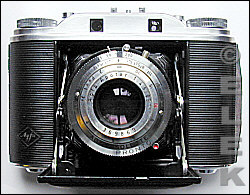Agfa Isolette III

|
|
|
| Style, film format | Folding 120 roll film with uncoupled rangefinder |
|
|
|
| Lens, shutter | Coated 85mm f/4.5 Apotar, Pronto |
|
|
|
| Photo quality | Good |
|
|
|
| Ergonomics | Very stable platform. |
|
|
|
If you think this looks like a serious camera, then you're right, if you mean serious fun. Not that it can't take "serious" photos with this roll-film camera, but its light weight and relative ease of operation take a lot of the drudgery out of photography.
This was the second classic camera that I bought. It came from Australia, and it was very clean though a little musty. It took some long time for the musty smell to disappear.
The Isolette III has an uncoupled rangefinder. There is a small dial on the top of the camera that you turn while peering through the rangefinder window. When the image is in focus, you read the distance from the dial and then set the lens to that same distance.
Next, set your aperture and shutter speed, tension the Pronto and press the shutter release to take your photo.
The Apotar is an average lens -- a bit better than most triplets and like most triplets get better when stopped down to f/8 or f/11. I also have a version with the Solinar, which is sharper, particularly when shot wide open.
The exterior of the camera is in lovely condition. However, there is a small repair to the bellows, which isn't unusual with the Agfa folders. The most common problems with many of the Agfa cameras are the use of the plastic bellows, which developed pinholes in the corners, and hardened lubricant in the helicals and other gears that made the lens often very difficult or impossible to turn.
The textured body covering on the Isolette III is very attractive and makes the camera easy to hold.
The back has a small sliding door that shows the frame number that is printed on the film's paper backing. Remember to close the door after advancing the film. Next to the film advance knob and just ahead of the shutter release is a small hole in the top plate. Under that is an indicator that tells the photographer if the film has been advanced. If it shows red, the film must be wound on. If it's clear, you're clear to shoot. This is opposite the Zeiss Ikon cameras, so I generally don't put both in the bag for a day of shooting.
Agfa did a nice job with the Isolette III. It's rounded shoulders and mostly symmetrical top plate are quite attractive. Once serviced, the Isolette III is a good camera to use and to show off to others.
